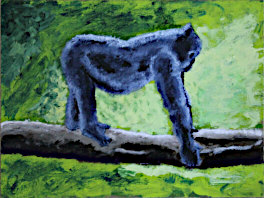Gorilla
(In a Tree)

Gorillas today are in two species: the western gorilla, Gorilla gorilla, and the eastern gorilla, Gorilla beringei. These species are each divided into two subspecies.
However, both species are in the family Hominidae. If that sounds familiar it's because humans are also in this family. Earlier classifications based on morphology put gorillas and other apes in separate families but genetic and DNA comparisons make it clear that humans, gorillas, and chimpanzees are on the same branch of the evolutionary tree. The irony is that when gorillas were first discovered by ancient seafarers, they were classified as people.
Originally it was accepted that people were closer to chimpanzees. But when the entire gorilla genome was analyzed it found that some people are actually closer to the gorilla with 98% of DNA in common.
Gorillas communicate with each other by sounds and gestures. They can also be taught to communicate with humans using sign language and acquire a vocabulary of about 1000 - 2000 words and put them together in sentences. When given IQ tests designed for children, gorillas can score up to 95. This is quite comparable to human IQ's with 100 being the average. As we know, it's possible to function normally - and even achieve distinction - with much lower scores. In fact one of the most famous - ah - "residents" of a well-known house of correction and who was played in a motion picture by actor Clint Kimbrough had an IQ of about 80.
Sometimes, though, the gorillas give a wrong answer because it's not the proper human response. For instance, if the question is "Where do you go when it rains?" the choice of answers could be 1) House, 2) Lake, 3) Mountain, or 4) Tree. The correct answer for a person is "House" but for a gorilla it would be "Tree".
In recent times there has been debate on whether gorillas and other great apes should be afforded the same protection as humans. Some have objected to this based on religious grounds since the Bible clearly states:
"Every moving thing that liveth shall be meat for you; even as the green herb have I given you all things." (Genesis 9:3)
So obviously it is the Divine Will has placed animals here at the pleasure of humans even to the point of being gobbled up.
Others, though, counter that given the clear proof that gorillas understand complex relationships and concepts and also feel emotions like people, they should have equal rights for life, liberty, and the pursuit of happiness (but not, as Thomas Jefferson originally wrote, the acquisition of property).
Besides the Bible says no such thing. Just go look up the original Hebrew:
כָּל־רֶ֙מֶשׂ֙ אֲשֶׁ֣ר הוּא־חַ֔י לָכֶ֥ם יִהְיֶ֖ה לְאָכְלָ֑ה כְּיֶ֣רֶק עֵ֔שֶׂב נָתַ֥תִּי לָכֶ֖ם אֶת־כֹּֽל׃
Now even the most dense can see that the word so cavalierly translated as "moving things":
רֶ֙מֶש
... and is pronounced "remes" is actually the Hebrew for "creeping things". In fact, from an indisputable source we know the word is based on the verb "rames" specifically meaning "creeping", "crawling", and even "teeming with vermin". And "remes" was specifically translated as "reptile".
So regardless of who is classifying the critters, gorillas and other apes may climb, walk, swing, or run. But one thing they do not do is to "creep" or "crawl". One authoritative source states that among the animals that do creep and crawl are alligators, ants, blind shingles, chameleons, crabs, crocodiles, earthworms, green basilisks, gusarapas (larva), komodo dragons, land snails, leatherback turtles, leeches, lizards, miñocas, moths, ereises, oysters, palolos, python, razor clams, sea slugs, sea snails, sea turtles, sloths, snout vipers, and terrestrial slugs. But nary mention of gorillas.
Of course, perhaps the gorillas greatest contribution to - ah - Hominoidkind - is the plethora of gorilla jokes. Amongst the most notable are:
What food did the Gorilla order when he went to France?
Ape Suzettes!
What is a gorillas favourite book to study in English class?
The Apes Of Wrath!
And of course there's the classic:
Knock-knock!
Who's there?
Gorilla.
Gorilla who?
Gorilla My Dreams!
References
"Gorilla", World Wildlife Federation.
"Gorillas More Related to People Than Thought, Genome Says", Dave Mosher, National Geographic, March 8, 2012.
"Chimps Belong on Human Branch of Family Tree, Study Says", National Geographic, John Pickrell, May 20, 2003.
"A Conversation With Koko the Gorilla", Roc Morin, The Atlantic, August 28, 2015.
"Hominid and Hominin – What's The Difference?", Beth Blaxland, Australian Museum, February 10, 2020.
Ben-Yehuda's Pocket English-Hebrew, Hebrew-English Dictionary, Ehud Ben-Yehuda (editor), David Weinstein (associate editor), 1961.
"27 Examples of Animals that Crawl", Garrett, Fauna Facts, February 24, 2022.